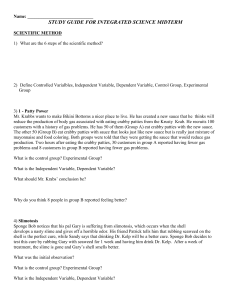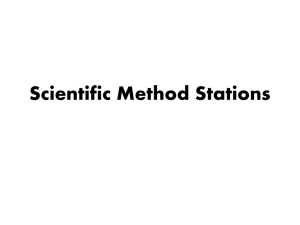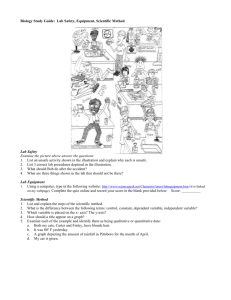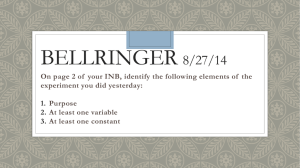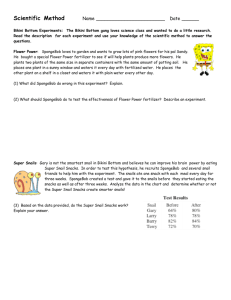STUDY GUIDE FOR INTEGRATED SCIENCE MIDTERM
advertisement
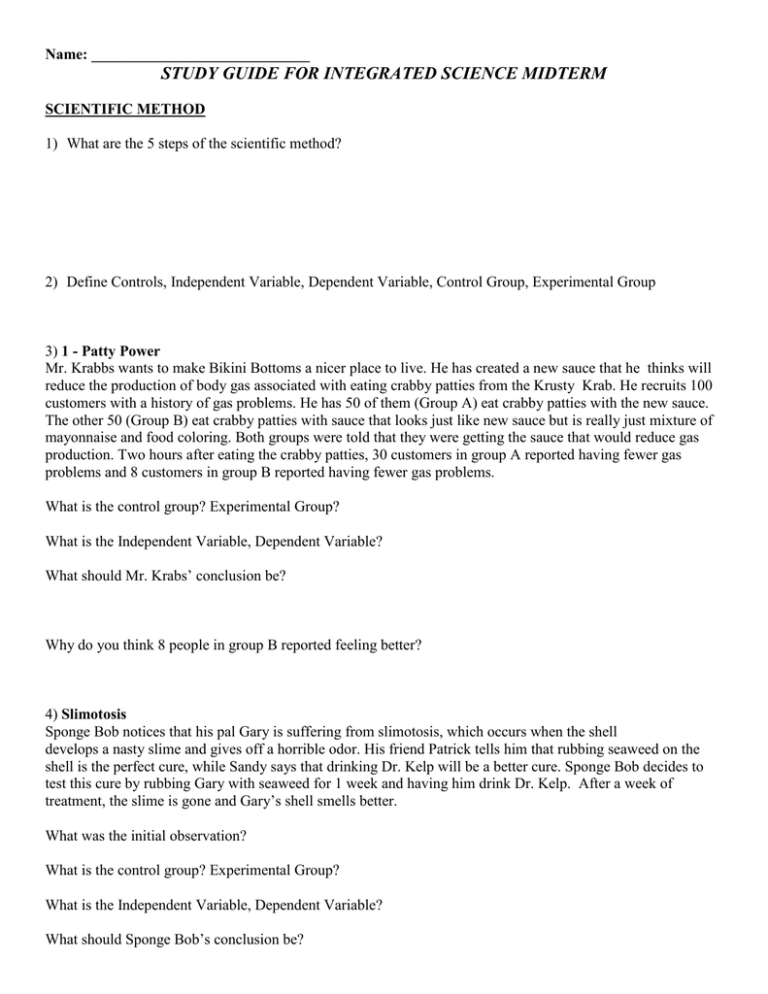
Name: _____________________________ STUDY GUIDE FOR INTEGRATED SCIENCE MIDTERM SCIENTIFIC METHOD 1) What are the 5 steps of the scientific method? 2) Define Controls, Independent Variable, Dependent Variable, Control Group, Experimental Group 3) 1 - Patty Power Mr. Krabbs wants to make Bikini Bottoms a nicer place to live. He has created a new sauce that he thinks will reduce the production of body gas associated with eating crabby patties from the Krusty Krab. He recruits 100 customers with a history of gas problems. He has 50 of them (Group A) eat crabby patties with the new sauce. The other 50 (Group B) eat crabby patties with sauce that looks just like new sauce but is really just mixture of mayonnaise and food coloring. Both groups were told that they were getting the sauce that would reduce gas production. Two hours after eating the crabby patties, 30 customers in group A reported having fewer gas problems and 8 customers in group B reported having fewer gas problems. What is the control group? Experimental Group? What is the Independent Variable, Dependent Variable? What should Mr. Krabs’ conclusion be? Why do you think 8 people in group B reported feeling better? 4) Slimotosis Sponge Bob notices that his pal Gary is suffering from slimotosis, which occurs when the shell develops a nasty slime and gives off a horrible odor. His friend Patrick tells him that rubbing seaweed on the shell is the perfect cure, while Sandy says that drinking Dr. Kelp will be a better cure. Sponge Bob decides to test this cure by rubbing Gary with seaweed for 1 week and having him drink Dr. Kelp. After a week of treatment, the slime is gone and Gary’s shell smells better. What was the initial observation? What is the control group? Experimental Group? What is the Independent Variable, Dependent Variable? What should Sponge Bob’s conclusion be? Make sure you can experiment using the scientific method to CORRECTLY test a single variable. Write a testable hypothesis that clearly states the Controls Ind. Variable and Dep Variable Make sure you can evaluate the effectiveness of an example experiment (are their steps missing, does the test correctly test a single variable, is there a hypothesis?) Below write out 2 different experiments of your choosing…you can use one from your classmates projects, but you can’t use one you have done already. No MENTOS! Make sure to include the following… o Problem, o Hypothesis, o Experimental Design (How is it set up, Independent Variable/Dependent Variabls, Controls, Control Group, Experimental Group) DATA You should be able to set up a simple scatter plot given a set of data. You should be able to set up a line graph given a simple set of data. You should be able to set up a series of bar graphs given a set of data. Each graph must include all elements needed (title, axes, labels, key, etc.) METRIC SYSTEM List all the base units from the metric system (length, mass, volume) List all the metric prefixes… Remember your pneumonic device!!! With each jump between prefixes in the metric system, the amount changes by an order of ___________________. (How much do you multiply or divide by in one step) 456 m = _____________________ mm 675.69 km = ___________________ mm 345 kl = ________________________ml 6) 957.95 mg = _____________________ kg 7) For the following things answer with the correct measurements (meter, liter or gram) mass of a penny length of a football field amount of air in a basketball density of a marble use a graduated cylinder to measure this use a triple beam balance to measure this You should be able to use a ruler, scale, and graduated cylinder to find length, mass, and volume respectively. Calculate density, volume or mass given the other 2 variables in a word problem. 1) A block of lead has dimensions of L=5.12 cm by W=3.45 cm by H=? The block weighs 1201 g. The density of the block is 1.1303 g/cm3. From this information, calculate the height of the block. 2) The mass of a beaker is 45.5g. When a marble is placed in the beaker, its combined weight of the beaker and marble is 64.5g. Also, when a graduated cylinder is filled with water to 10ml of water, and the marble is dropped in, the water level rises to 25.5ml. What is the density of the marble? Calculate density of irregular objects using tools available in class. (think how you could find mass and volume!) INTRO TO MATTER 8) For the following things give the proper state of matter (solid, liquid, gas) CO2 H20 Sugar metal steam Fixed Shape and Fixed Volume No Fixed shape No fixed shape and no fixed volume 2) What is matter? 3) Identify the following as intensive or extensive properties: Color Mass Volume Malleability Conductivity Length Reactivity 3) ID the following as Mixture, Element or Compound: water sand in water salt water oil in water milk carbon carbon dioxide hydrogen What is the Tyndall effect? What type of solutions show tyndall? What is a period on the periodic table? Give one example What is a group on the periodic table? Give one example How many valence electrons does Carbon have? Boron? Neon? Out of the 3, which is the most stable and why? How many outer shells does Hydrogen have? Helium? Silicon? Metals are likely to (give up or take) electrons while non-metals are more likely to (give up or take) electrons. What are 4 properties of metals? Draw the bohr diagram, for the following elements: a) Calcium c) Flourine b) Oxygen d) Magnesium Properties of Matter: 1. What is Matter? 2. What is the difference between a pure substance and a mixture? 3. Know the difference between an atom, molecule, compounds, mixture and examples of each. 4. What are the 3 phases of matter? Sketch and explain how they differ. 5. What is the difference between a physical and a chemical property? Give 3 examples of each. 6. What are intensive vs. extensive physical properties and examples Chemical and Physical Changes 1. What is a chemical change? Give 2 examples from labs we have done or the webquest. 2. What is a physical change? Give 2 examples from labs we have done or the webquest. 3. What are 4 signs that indicate a chemical change has occurred? Solution, Colloid and Suspension 1. What is a true solution? 2. How do particle sizes differ between solutions, colloids and suspensions? 3. What are 2 tests that you can perform to see if you have a solution, colloid or suspension? 4. What is the Tyndall effect? Of the 3 types of mixtures in the lab, which will always show the tyndall? 7. Of the 3 types of mixtures, which will always separate upon standing? Alchemy 1. What is Alchemy? 2. Why was Alchemy important to science? 3. What part of alchemy were you trying to re-create with the penny lab? 4. Since you did not make gold what really happened in this lab? - What turned the penny silver in the zinc solution? - What made the penny appear gold in the flame? 5. What results did you use to determine that the substance you created was not actually gold? 6. What is an alloy? 7. What alloy did you create in your alchemy lab? 8. List another example of an alloy, and an advantage that alloys can have over other materials. Define all the parts of an atom: protons, neutrons, electrons, nucleus, electron cloud. PERIODIC TABLE How is the periodic table arranged that makes it very convenient? Make sure to be able to differentiate between Metals, Nonmetals, and Metalloids. How can you test a substance to determine whether you have Metals, Nonmetals, and Metalloids. List all of the element groups of the periodic table below. Make sure to describe MANY of the common characteristics of each group, and know where each group is located. RADIOACTIVTY What is radioactivity? What is radioactive decay? What are the 3 types of radioactive decay? NOTES: (What questions do you have? As you fill out the study guide, write notes down here!!)
